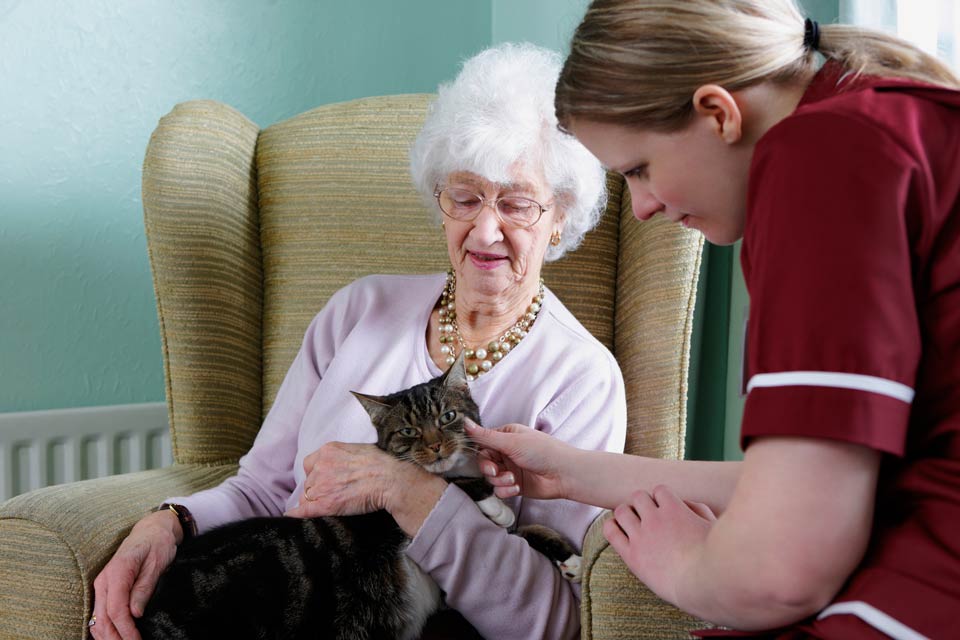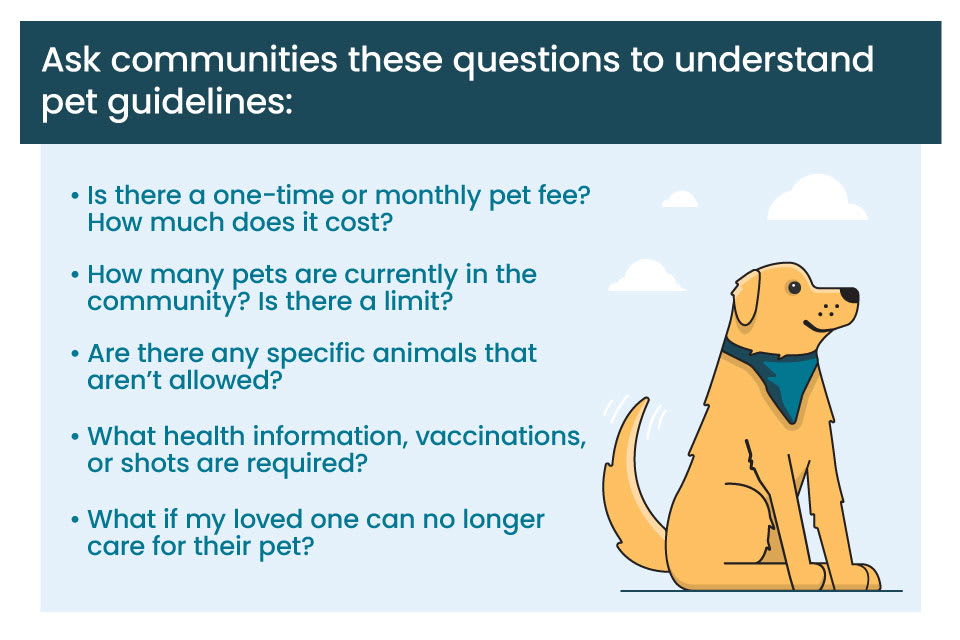Key Takeaways
Most assisted living facilities allow pets, but the rules can vary significantly from one place to another.
It’s essential to understand the specific pet policies, including size, breed restrictions, and any additional fees.
Pets can provide emotional support, companionship, and therapeutic benefits to seniors in care homes.
Research thoroughly to find a pet-friendly facility, and ask specific questions during tours to ensure the best fit for you and your pet.
Preparing for the move with your pet involves ensuring their health, comfort, and having all necessary supplies.
Overview: Bringing Pets into Care Homes
Transitioning to an assisted living facility can be a significant change for seniors. One of the biggest concerns is whether they can bring their beloved pets along. Fortunately, many facilities recognize the benefits of allowing pets and have pet-friendly policies in place.
Importance and Benefits of Pets in Senior Living
Pets play a crucial role in the lives of many seniors. They provide companionship, reduce feelings of loneliness, and even offer health benefits like lowering blood pressure and reducing stress. Having a pet can make the transition to assisted living much smoother.
“Cats in Assisted Living Situations” from www.cathealth.com and used with no modifications.
Understanding Pet Policies in Assisted Living Facilities
Before moving into an assisted living facility with a pet, it’s important to understand the specific pet policies. Each facility has its own set of rules and guidelines that must be followed.
General Guidelines for Pet Ownership
Most assisted living communities allow pets, but the guidelines can vary. Generally, facilities will have rules regarding the type and size of pets allowed, the number of pets a resident can have, and any associated fees or deposits.
Type and Size Restrictions
Many facilities have restrictions on the types of pets they allow. For example, some may only allow cats and small dogs, while others might permit larger breeds. It’s essential to check with the facility to understand their specific restrictions.
“Each senior care facility has pet policies and rules that may differ from other senior living facilities. Seniors who are preparing to move into a senior living community need to understand all the pet-related rules that apply to their pets.”
Number of Pets Allowed
In addition to type and size restrictions, facilities may also limit the number of pets a resident can have. This is to ensure that both the pets and residents can live comfortably and safely.
Associated Fees and Deposits
Many assisted living facilities charge an initial fee or deposit for pets. This fee covers any potential damage and the extra cleaning required. It’s important to ask about these fees upfront to avoid any surprises.
“Pet-Friendly Assisted Living | A Place …” from www.aplaceformom.com and used with no modifications.
How to Find a Pet Friendly Care Facility
Finding a pet-friendly care facility requires thorough research and asking the right questions. Here are some steps to help you find the perfect place for you and your pet.
Researching Online and Offline Options
Start by searching online for pet-friendly assisted living facilities in your area. Websites often provide detailed information about their pet policies. Additionally, you can ask friends, family, or healthcare providers for recommendations.
“Retirees interested in finding an assisted living community nearby that accepts pets can easily search by zip code or specific pet policies online.”
Questions to Ask During a Facility Tour
When touring potential facilities, ask specific questions about their pet policies. Here are some questions to consider:
For example, you might want to know if they have pet-safe evergreen shrubs in their outdoor areas to ensure a safe environment for your pets.
What types and sizes of pets are allowed?
Is there a limit on the number of pets a resident can have?
Are there any additional fees or deposits required for pets?
What amenities and services are available for pets?
Reviewing Pet Amenities and Services
When considering a pet-friendly assisted living facility, it’s crucial to review the amenities and services available for your furry friend. Some facilities offer a range of pet-related services that can make life easier for both you and your pet. Look for facilities that provide grooming services, pet walking, and have nearby veterinary care. These services ensure that your pet remains healthy and well-cared for.
Benefits of Having Pets in Assisted Living
Pets can significantly enhance the quality of life for seniors in assisted living facilities. They provide numerous benefits that can improve both physical and mental health.
Emotional Support and Companionship
One of the primary benefits of having a pet is the emotional support and companionship they provide. Pets can help reduce feelings of loneliness and isolation, which are common among seniors. They offer unconditional love and can be a source of comfort during difficult times. For more information on pet-friendly facilities, check out this guide on pet-friendly assisted living.
For example, a senior who has recently lost a spouse may find solace in the companionship of a pet. The presence of a pet can help fill the emotional void and provide a sense of purpose and routine.
Therapeutic Benefits
Pets also offer therapeutic benefits. Studies have shown that interacting with pets can lower blood pressure, reduce stress, and even alleviate symptoms of depression. The simple act of petting a dog or cat can release endorphins, which are chemicals in the brain that promote a sense of well-being.
Moreover, pets can encourage seniors to stay active. Walking a dog, for instance, provides regular exercise, which is beneficial for physical health. This activity can help improve mobility, flexibility, and overall fitness.
Increased Social Interaction
Having a pet can also increase social interaction. Pets are natural icebreakers and can help seniors connect with others. For example, walking a dog can lead to conversations with neighbors and other pet owners. This social interaction is vital for mental health and can help combat feelings of loneliness and isolation.
In assisted living facilities, pets can also help residents bond with each other. Shared pet ownership or participation in pet-related activities can create opportunities for socialization and foster a sense of community.
Preparing for the Move with Your Pet
Moving to an assisted living facility can be a significant change for both you and your pet. Proper preparation can help ensure a smooth transition and make the process less stressful.
Health Check and Vaccination Requirements
Before moving, ensure that your pet is up-to-date on all vaccinations and has had a recent health check. Most facilities will require proof of vaccinations to ensure the safety and health of all residents and their pets. Schedule a visit with your veterinarian to get a health certificate and discuss any concerns you may have about the move.
Pet Comfort and Familiarity
It’s important to make your pet feel as comfortable as possible during the move. Bring familiar items such as their bed, toys, and feeding bowls. These items can provide a sense of security and help your pet adjust to the new environment more quickly.
Additionally, try to maintain your pet’s routine as much as possible. Consistency in feeding times, walks, and playtime can help reduce stress and make the transition smoother for your pet. For more information, you can check out pet-friendly assisted living resources.
Essential Pet Supplies to Bring
When moving to an assisted living facility, ensure you have all the essential supplies for your pet. Here’s a list of items to consider bringing:
Food and water bowls
Pet food and treats
Leash and collar
Litter box and litter (for cats)
Bedding and blankets
Toys and grooming supplies
Medical records and medications
Having these supplies on hand will help your pet feel more at home and ensure they have everything they need.
Ensuring Pet Care in Assisted Living
Once you’ve moved into the assisted living facility, it’s important to establish a routine and ensure your pet receives proper care. This includes daily care routines, access to grooming and veterinary services, and opportunities for exercise.
Daily Care Routines
Maintaining a consistent daily care routine is crucial for your pet’s well-being. Ensure that feeding, walking, and playtime occur at regular intervals. This routine provides structure and can help your pet feel more secure in their new environment.
For instance, feeding your pet at the same times each day helps them know what to expect and reduces anxiety. Regular walks and playtime also ensure they get the exercise they need to stay healthy.
Access to Pet Grooming and Veterinary Services
Regular grooming and veterinary care are essential for your pet’s health. Many assisted living facilities offer on-site grooming services or have partnerships with local groomers and veterinarians. Ensure you have access to these services and schedule regular appointments to keep your pet in top condition.
Availability of Pet Walking and Exercise Options
Exercise is crucial for your pet’s physical and mental health. Look for facilities that offer designated pet walking areas or have nearby parks. Regular exercise helps keep your pet fit and can prevent behavioral issues caused by boredom or excess energy. For more information on finding such facilities, check out Pet Friendly Senior Advisor.
If you have mobility issues or need assistance, some facilities offer pet walking services. These services ensure your pet gets the exercise they need, even if you are unable to provide it yourself.
Shared Responsibilities among Family and Staff
Taking care of a pet in an assisted living facility often requires collaboration between family members and staff. Family members can help with pet care during visits, and staff can assist with daily tasks. This shared responsibility ensures that the pet receives consistent care and attention. For more information on finding a suitable facility, visit Pet Friendly Senior Advisor.
Monitoring Pet Health and Behavior
Regularly monitoring your pet’s health and behavior is essential. Keep an eye out for any changes in eating habits, energy levels, or behavior. If you notice any concerns, consult with a veterinarian promptly. Early detection of health issues can prevent more serious problems down the line.
Additionally, make sure your pet is comfortable and happy in their new environment. Watch for signs of stress or anxiety, such as excessive barking, hiding, or changes in appetite. Addressing these issues early can help your pet adjust more easily. For more information on how to ensure your pet’s well-being, visit Pet Friendly Senior Advisor.
Utilizing Pet Care Services Offered
Many assisted living facilities offer pet care services to help residents manage their pets’ needs. These services can include grooming, walking, and even pet sitting. Take advantage of these services to ensure your pet receives the best care possible.
For example, if you have a medical appointment or need to be away for an extended period, arranging for pet sitting can provide peace of mind. Knowing that your pet is in good hands allows you to focus on your own health and well-being.
Finding the Right Balance for Everyone
Balancing the needs of both the senior resident and their pet is crucial for a successful transition to assisted living. Ensuring that both parties are happy and well-cared for requires careful planning and communication. For example, choosing pet-safe plants can help create a safer environment for both seniors and their pets.
Ensuring Happiness and Well-being
The well-being of both the senior and their pet is paramount. Regularly check in with both to ensure they are comfortable and content. Address any concerns promptly and make adjustments as needed to improve their quality of life.
For instance, if a pet seems anxious or a senior feels overwhelmed by pet care responsibilities, consider seeking additional support or making changes to the routine. Ensuring both are happy and healthy will lead to a more positive living experience. For more information, you can explore resources on pet-friendly assisted living.
Adhering to Facility Guidelines
It’s essential to adhere to the facility’s pet policies and guidelines. This ensures a harmonious living environment for all residents and their pets. Follow all rules regarding pet behavior, cleanliness, and care to maintain a positive relationship with the facility staff and other residents. For more information on pet-friendly plants, check out pet-friendly sweet alyssum.
By respecting the facility’s guidelines, you help create a pet-friendly community where everyone can enjoy the benefits of pet ownership.
Frequently Asked Questions (FAQ)
Here are some common questions about having pets in assisted living facilities:
Can all assisted living facilities accommodate pets?
Not all assisted living facilities allow pets. It’s important to research and find a pet-friendly facility that meets your needs.
What types of pets are generally not allowed?
Many facilities have restrictions on certain types of pets, such as large dogs, exotic animals, or breeds considered aggressive. Always check the specific pet policy of the facility. For instance, some facilities may prohibit pets like aggressive dog breeds.
Are there any health benefits to having pets in senior living?
Yes, pets can provide numerous health benefits, including lowering blood pressure, reducing stress, and alleviating symptoms of depression. They also encourage physical activity and social interaction.
How can I ensure my pet adapts to living at an assisted living facility with me?
To help your pet adapt, maintain their routine, bring familiar items, and provide plenty of love and attention. Monitor their behavior and consult with a veterinarian if you notice any signs of stress or anxiety.
Bringing a pet into an assisted living facility can significantly enhance the quality of life for seniors. By understanding pet policies, preparing for the move, and ensuring proper care, you can create a positive and enriching environment for both the senior and their beloved pet. For example, knowing about pet-friendly plants can help in creating a safe and enjoyable space for pets in these facilities.






